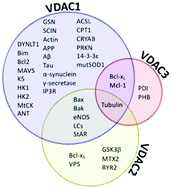当前位置:
X-MOL 学术
›
Mol. Biosyst.
›
论文详情
Our official English website, www.x-mol.net, welcomes your feedback! (Note: you will need to create a separate account there.)
Protein–protein interaction networks as a new perspective to evaluate distinct functional roles of voltage-dependent anion channel isoforms
Molecular BioSystems Pub Date : 2017-10-04 00:00:00 , DOI: 10.1039/c7mb00434f Marianna Caterino 1, 2, 3, 4, 5 , Margherita Ruoppolo 1, 2, 3, 4, 5 , Annalisa Mandola 3, 4, 6, 7, 8 , Michele Costanzo 1, 2, 3, 4, 5 , Stefania Orrù 3, 4, 7, 8, 9 , Esther Imperlini 4, 9, 10
Molecular BioSystems Pub Date : 2017-10-04 00:00:00 , DOI: 10.1039/c7mb00434f Marianna Caterino 1, 2, 3, 4, 5 , Margherita Ruoppolo 1, 2, 3, 4, 5 , Annalisa Mandola 3, 4, 6, 7, 8 , Michele Costanzo 1, 2, 3, 4, 5 , Stefania Orrù 3, 4, 7, 8, 9 , Esther Imperlini 4, 9, 10
Affiliation

|
Voltage-dependent anion channels (VDACs) are a family of three mitochondrial porins and the most abundant integral membrane proteins of the mitochondrial outer membrane (MOM). VDACs are known to be involved in metabolite/ion transport across the MOM and in many cellular processes ranging from mitochondria-mediated apoptosis to the control of energy metabolism, by interacting with cytosolic, mitochondrial and cytoskeletal proteins and other membrane channels. Despite redundancy and compensatory mechanisms among VDAC isoforms, they display not only different channel properties and protein expression levels, but also distinct protein partners. Here, we review the known protein interactions for each VDAC isoform in order to shed light on their peculiar roles in physiological and pathological conditions. As proteins associated with the MOM, VDAC opening/closure as a metabolic checkpoint is regulated by protein–protein interactions, and is of pharmacological interest in pathological conditions such as cancer. The interactions involving VDAC1 have been characterized more in depth than those involving VDAC2 and VDAC3. Nevertheless, the so far explored VDAC–protein interactions for each isoform show that VDAC1 is mainly involved in the maintenance of cellular homeostasis and in pro-apoptotic processes, whereas VDAC2 displays an anti-apoptotic role. Despite there being limited information on VDAC3, this isoform could contribute to mitochondrial protein quality control and act as a marker of oxidative status. In pathological conditions, namely neurodegenerative and cardiovascular diseases, both VDAC1 and VDAC2 establish abnormal interactions aimed to counteract the mitochondrial dysfunction which contributes to end-organ damage.
中文翻译:

蛋白质-蛋白质相互作用网络作为评估电压依赖性阴离子通道同工型不同功能作用的新视角
电压依赖性阴离子通道(VDAC)是三个线粒体孔蛋白和线粒体外膜(MOM)中最丰富的整体膜蛋白的家族。已知VDAC通过与胞质,线粒体和细胞骨架蛋白以及其他膜通道相互作用,参与了跨MOM的代谢物/离子运输,并参与了许多细胞过程,从线粒体介导的细胞凋亡到能量代谢的控制。尽管VDAC亚型之间存在冗余和补偿机制,但它们不仅显示出不同的通道特性和蛋白表达水平,而且显示出不同的蛋白伴侣。在这里,我们审查了每种VDAC同工型的已知蛋白质相互作用,以阐明它们在生理和病理状况中的特殊作用。作为与MOM相关的蛋白质,VDAC作为代谢检查点的打开/关闭受蛋白质间相互作用的调节,在诸如癌症等病理状况中具有药理学意义。与涉及VDAC2和VDAC3的交互相比,涉及VDAC1的交互具有更深的表征。然而,到目前为止,探索的每种同工型的VDAC-蛋白质相互作用表明,VDAC1主要参与细胞稳态的维持和促凋亡过程,而VDAC2显示出抗凋亡作用。尽管有关VDAC3的信息有限,但这种同工型可能有助于线粒体蛋白质的质量控制并充当氧化状态的标志。在病理状况下,即神经退行性疾病和心血管疾病,
更新日期:2017-11-21
中文翻译:

蛋白质-蛋白质相互作用网络作为评估电压依赖性阴离子通道同工型不同功能作用的新视角
电压依赖性阴离子通道(VDAC)是三个线粒体孔蛋白和线粒体外膜(MOM)中最丰富的整体膜蛋白的家族。已知VDAC通过与胞质,线粒体和细胞骨架蛋白以及其他膜通道相互作用,参与了跨MOM的代谢物/离子运输,并参与了许多细胞过程,从线粒体介导的细胞凋亡到能量代谢的控制。尽管VDAC亚型之间存在冗余和补偿机制,但它们不仅显示出不同的通道特性和蛋白表达水平,而且显示出不同的蛋白伴侣。在这里,我们审查了每种VDAC同工型的已知蛋白质相互作用,以阐明它们在生理和病理状况中的特殊作用。作为与MOM相关的蛋白质,VDAC作为代谢检查点的打开/关闭受蛋白质间相互作用的调节,在诸如癌症等病理状况中具有药理学意义。与涉及VDAC2和VDAC3的交互相比,涉及VDAC1的交互具有更深的表征。然而,到目前为止,探索的每种同工型的VDAC-蛋白质相互作用表明,VDAC1主要参与细胞稳态的维持和促凋亡过程,而VDAC2显示出抗凋亡作用。尽管有关VDAC3的信息有限,但这种同工型可能有助于线粒体蛋白质的质量控制并充当氧化状态的标志。在病理状况下,即神经退行性疾病和心血管疾病,



























 京公网安备 11010802027423号
京公网安备 11010802027423号